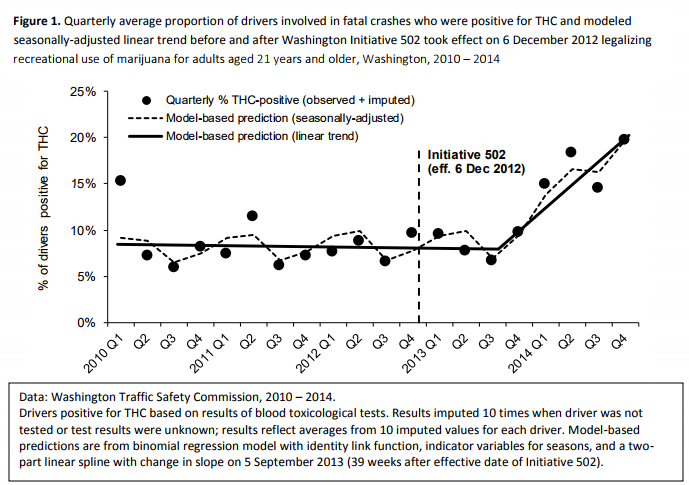
Prevalence of Marijuana Involvement in Fatal Crashes: Washington, 2010-2014
This study quantifies the prevalence of marijuana involvement in fatal crashes in the state of Washington in years 2010 – 2014, and examines whether the prevalence changed after the legalization of recreational use of marijuana took effect in the state.
May 2016
Suggested Citation
For media inquiries, contact:
Tamra Johnson
202-942-2079
TRJohnson@national.aaa.com
Abstract
This study quantifies the prevalence of marijuana involvement in fatal crashes in the state of Washington in years 2010 – 2014. Also included is an Investigation into whether the prevalence changed after legalization of recreational use of marijuana and creation of a new per se limit for driving under the influence of marijuana which took effect in December 2012.
Background
- In November 2012, the citizens of the state of Washington approved by popular vote ballot Initiative 502, which allows adults aged 21 years and older to possess up to 1 ounce of marijuana for personal use
- The new law became effective on December 6, 2012
- Not much is known about the prevalence of driving after using marijuana or the prevalence of recent marijuana use among drivers involved in crashes primarily due to data limitations. In January 2016, the Washington Traffic Safety Commission (WTSC) made available the results of toxicology tests for THC performed on drivers involved in fatal crashes in the state of Washington, and appended these new data to their database of all drivers involved in fatal crashes statewide
- This study uses these new data from the WTSC to estimate the proportion of drivers in fatal crashes in the state of Washington who had a detectable concentration of THC in their blood at the time of the crash and to investigate whether that proportion changed after Washington Initiative 502 took effect on December 6, 2012
Objective
The purpose of this study was to quantify the prevalence of marijuana involvement in fatal crashes in the state of Washington in years 2010 – 2014 and to investigate whether the prevalence changed after Washington Initiative 502, which legalized recreational use of marijuana for adults aged 21 years and older, took effect on December 6, 2012
Methods
- The data examined were obtained from the WTSC and comprised a census of all motor vehicle crashes that occurred on public roads in the state of Washington and resulted in a death within 30 days
- Examined the presence and concentration of delta-9-tetrahydrocannabinol (hereafter THC), the main psychoactive chemical in marijuana, in the blood toxicological test results of drivers involved in fatal crashes
- THC presence and concentration in the subset of drivers whose blood was not tested or whose test results were unavailable were estimated using the method of multiple imputation. The imputation method explicitly accounted for changes implemented during the study period in the cutoff levels used in the state laboratory for detection of THC
Key Findings
- Statewide, 3,031 drivers were involved in fatal crashes in years 2010 – 2014
- Overall, considering both the actual blood toxicology test results and imputed results, an estimated 303 drivers—10.0% of all drivers involved in fatal crashes in Washington between 2010 and 2014— had detectable THC in their blood at the time of the crash
- Of all THC-positive drivers involved in fatal crashes, an estimated 34.0% had neither alcohol nor other drugs in their blood, 39.0% had detectable alcohol in addition to THC, 16.5% had other drugs in addition to THC, and 10.5% had had both alcohol and other drugs in addition to THC in their blood at the time of the crash
- From 2010 through 2013, the estimated number and proportion of drivers involved in fatal crashes who had a detectable concentration of THC in their blood ranged from a low of 48 (7.9%) to a high of 53 (8.5%)
- The number and proportion both doubled from 49 (8.3%) in 2013 to 106 (17.0%) in 2014
- Analysis of trends over time before and after Initiative 502 took effect indicate that the proportion of drivers positive for THC was generally flat before Initiative 502, but began increasing significantly approximately 9 months after the effective date of Initiative 502
Suggested Citation
For media inquiries, contact:
Tamra Johnson
202-942-2079
TRJohnson@national.aaa.com
